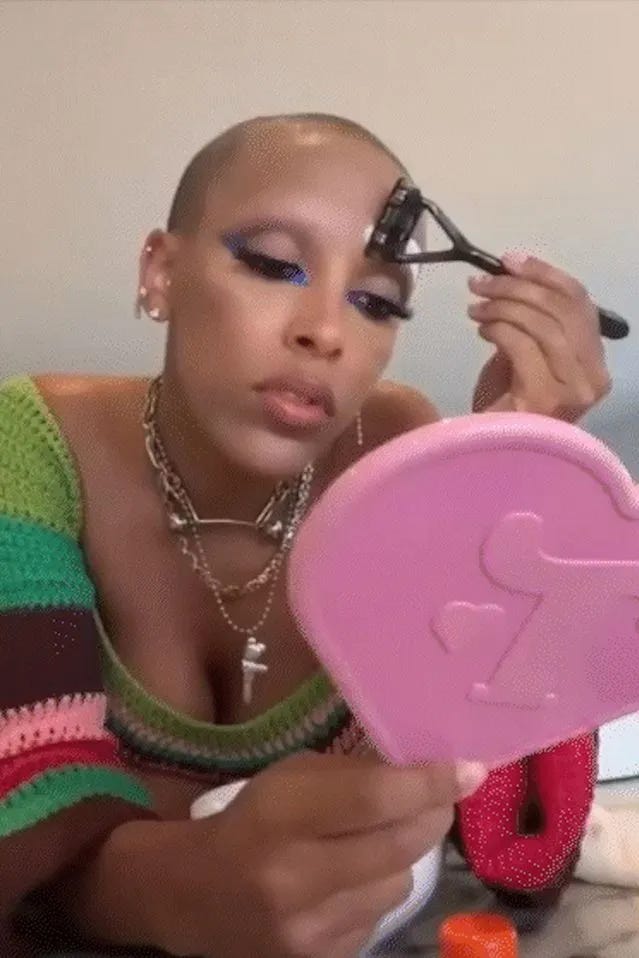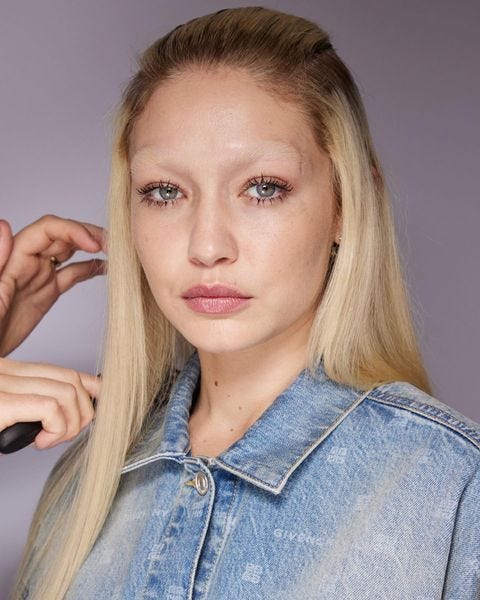Over the past few months, celebrity eyebrows have gone missing. Kim Kardashian, Kendall Jenner, and Kylie Jenner bleached theirs into oblivion. Doja Cat shaved hers off. The Hadid sisters are experimenting with the empty-forehead look, as is Jodie Turner-Smith. A no-eyebrows filter is having a moment on TikTok.
All this prompted fashion journalist Isabel Sloane to ask, “Are No Eyebrows the New Eyebrows?” in a recent piece for the Wall Street Journal. The (excellent) article analyzes centuries of invisible arches, from Mona Lisa to modern queer trendsetters:
“Going browless is not an inherently modern phenomenon. In the Middle Ages, women plucked their eyebrows and hairlines to create the illusion of an elongated forehead—a mark of beauty and intelligence. Italian Renaissance paintings, likewise, show how light and imperceptible women’s eyebrows then were. Just picture the Mona Lisa: Her smile you can see, but her eyebrows are barely there.”
The current wave of brow-free faces follows a Y2K fashion revival, during which supermodel Bella Hadid and others reclaimed the thin brows of the ’90s and aughts. Mx. Chiara, who uses the gender-neutral honorific, suggested that brow-ditching celebrities and their aestheticians could be taking a cue from young, queer people on social media, whose well-documented eyebrow experiments predate the summer.
I do, however, want to challenge the story’s claim that “The Great Depilation” is low-maintenance, requiring “just a quick swipe of a razor or a coat of bleach every week or two.”
First, this trend cycle is stunningly simple to follow if you follow the money. The thin brows of the 1990s and early 2000s (think: Gwen Stefani in No Doubt) gave way to the thick, dark brows of the 2010s (think: Cara Delevingne) because thick, dark brows meant the sale of growth serums, pencils, powders, and gels, plus appointments for microblading, tinting, laminating, and more. Thick, dark brows are now giving way to bleached brows because bleached brows mean the sale of bleach, brand new shades of pencils, powders, and gels, plus skincare for bleach irritation, concealer for skin-brow blending, and/or frequent touch-up appointments. The product possibilities are endless — and the exact opposite of what consumers already have on hand. It makes perfect sense that this would be The Next Big Brow Thing.
What’s more, barely-there brows are considered “cool” only when they are integrated into a high-aesthetic-labor look. The images used in the WSJ article all reflect this. In order to be celebrated as “trendy,” bleached or shaved brows must be surrounded by obvious makeup or another form of adornment: brightly-colored hair, lots of jewelry, a stylish outfit, distractingly shiny skin, a surgically-enhanced face. Either that, or they must be marked by obvious aesthetic intervention themselves: the telltale contrast of bleach, the no-stubble smoothness of shaving. The overall vibe must convey effort. It must seem deliberate.
I say this as someone who currently has no eyebrows — with no effort! — courtesy of an illness. I say this as someone who is close to others who have lost their eyebrows undergoing chemotherapy. The general public does not consider our symptoms cool or beautiful or “alien-like” or edgy. The beauty media does not see us as trend-setters. It sees us as sick, and sees that sickness as an opportunity to sell us pencils, powders, and procedures to fill up our vacant brow bones — because, as I’ve said before, the standard of beauty now is basically just “stimulates the economy.”
“No Eyebrows” are only the “New Eyebrows” if your “No Eyebrows” are the result of funneling money, time, and effort into your face.
If this trend is the result of anything other than the cyclical nature of capitalist production, though, it is the (related) Julia Fox Effect: Beauty enthusiasts want to appear to push back on beauty standards without actually pushing back on anything at all.
“Pretty is over,” Fox declared upon lightening her eyebrows in June 2022. Conveniently, she’s molded her face and body to meet the cultural ideal of “pretty” in every other imaginable way, and thus absorbs no personal or political risk by un-prettying herself in this particular way. (Remember: The “standard of beauty” is not one fixed thing, but a constantly shifting set of parameters that allows for some deviation by design.)
Makeup artist Erin Parsons echoed Fox’s sentiment when she told Diet Prada, “We’ve had these over perfected ‘Instagram brows’ for over a decade now. I sense people today want to be unique.” Diet Prada went on to hail invisible eyebrows as “a bold rejection of homogenization and artificiality.” But how? Glomming onto the latest eyebrow look doesn’t reject homogenization; it redirects it. Bleaching or shaving one’s brows away doesn’t reject artificiality; it requires it. The only brows that have a legitimate claim to individuality or authenticity are your own unmodified eyebrows, as they are.
As it is, the deliberately-disappeared brow trend conveys conformity in the way that matters most these days: a commitment to consuming, and to embodying that consumption like an identity, product intervention splashed across your face as if to say, “Don’t let my alternative appearance fool you — I still only believe in the kind of beauty you can buy.”








I want everyone to know that I know I sent this out with a typo in the last sentence and it is KILLING me!!! That should have said “Don’t let *my* alternative appearance fool you — I still only believe in the kind of beauty you can buy" — not "me" !!!
". . . the standard of beauty now is basically just 'stimulates the economy.'" Well said. That's the thing—the fashion thing, the tech thing, the car thing, the every thing.